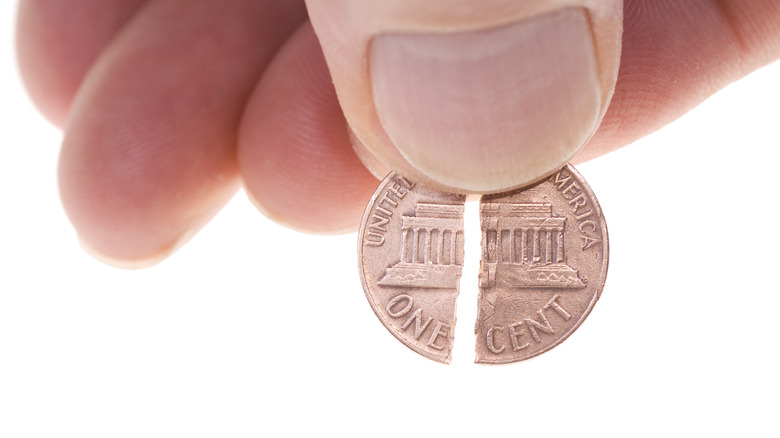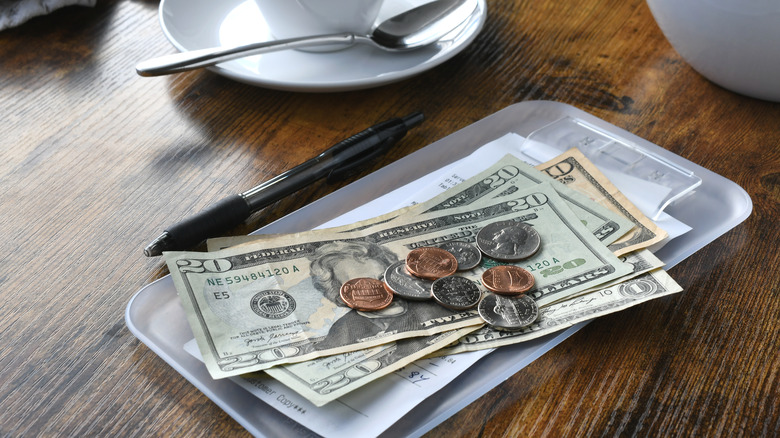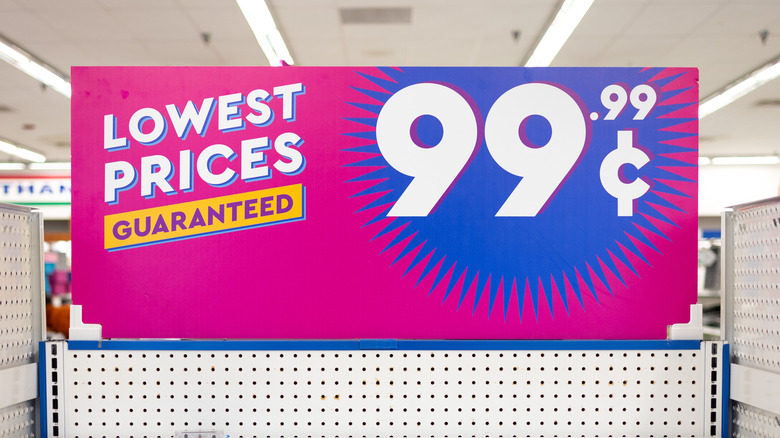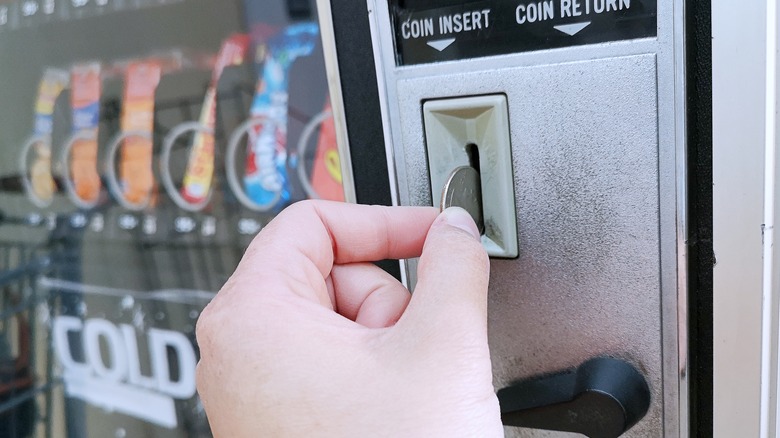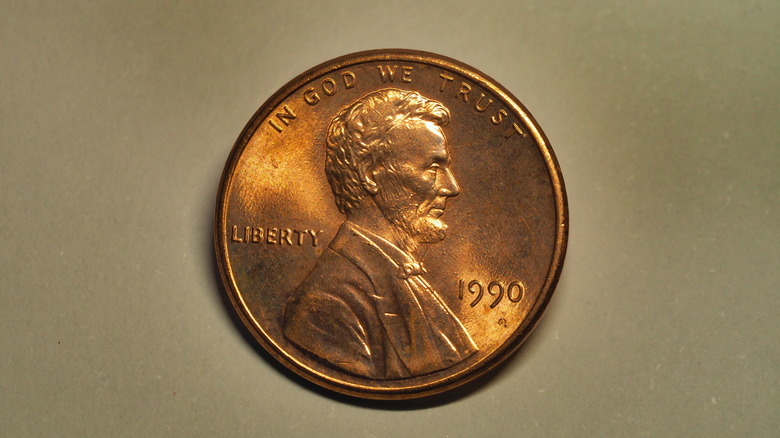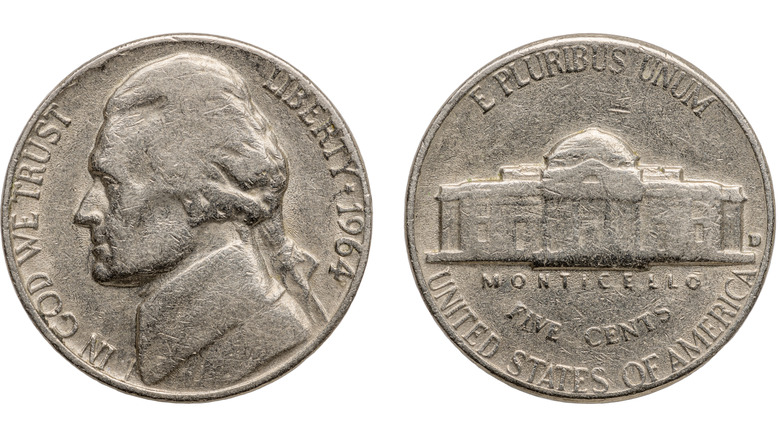8 Unexpected Ways America's Penny Shortage Might Affect You
The American penny is the most circulated coin denomination in U.S. history. Although the ubiquitous Lincoln design has enjoyed the longest production timeline, the penny has undergone various iterations throughout history. Since the first U.S. penny, known as the chain cent, was produced in 1793, the U.S. Mint has circulated an estimated 300 billion pennies. Despite this ubiquitous usage and impressive mintage, the penny has been a hot-button topic among economists and politicians seeking to rein in perceived waste in the federal budget. For decades, a debate has raged over the fiscal viability of the penny. Aside from the nickel, the U.S. penny is the only coin that costs more to produce than it is worth. It costs the government 3.7 cents to produce a single penny.
Although coin availability has fluctuated throughout history, one of the more prominent shortages occurred in the aftermath of pandemic-era lockdowns. In this case, the issue wasn't a lack of available coins but rather a dearth of public spending. Instead of bouncing between hands as coins do in a healthy economy, they sat idle. This COVID-specific coin shortage has collided with the Trump administration's outright cancellation of the penny. Under the cost-saving nose of the Department of Government Efficiency, President Donald Trump cited the denomination's wasteful production and decreed that the Treasury cease penny minting. On November 12, 2025, the U.S. Mint issued its final penny, putting an end to the denomination's 232-year run.
The U.S. is joining a growing list of countries that have phased out lower-denomination currency. Others include Canada, New Zealand, and Australia. As everyday citizens in these countries discovered, a rug pull of an economy's smallest coin denomination can wreak havoc. Here are eight ways America's penny shortage might affect you, along with some ways to alleviate the disruption.
The rounding on cash purchases
In the post-penny economy, consumers might be surprised to see their totals at store checkouts rounded to the nearest nickel when paying in cash. Of course, digital payments will remain unchanged as exact charges can still be applied. Now, whether your bill is rounded down or up is the real surprise. Following the government's out-of-the-blue announcement regarding the penny's ouster, many companies have complained about the lack of direction on how businesses should handle the disruption. The result is an uneven financial terrain that customers are forced to navigate in the dark, further complicated by an atomized service sector operating out of sync. The penny shortage is having an unexpected impact on banks, too, which are struggling to maintain enough pennies to give clientele exact change.
So far, many companies have proactively announced a willingness to spare their customers by rounding down to the nearest five cents. Love's Travel Stops — the nationwide gas station and convenience store brand — announced plans to drop prices for consumers at locations that fall short on pennies. But the move certainly isn't unanimous. For example, McDonald's recently announced plans to round to the nearest nickel, meaning some cash payments will be higher and some will be lower. And plenty of companies are just rounding everything up, effectively offloading the financial toll on their customers.
While a few cents look fairly meaningless on a single transaction, the hidden "rounding tax" can add up quickly. According to the Federal Reserve Bank of Richmond, service providers that do round up could cost U.S. customers roughly $6 million yearly. If you're paying with cash, make sure to check the rounding policies. You won't sweat a few cents extra on one outing, but over time the practice can snowball into a hidden expense.
The brunt felt by lower-income Americans
According to a 2025 YouGov poll, 42% of adults strongly or somewhat support ending the penny's production. This anti-cent sentiment is up from 34% in 2014, signaling a rising tide of apathy. This plurality support for a penniless future risks overlooking the 30% of people who still oppose the coin's elimination. While the opposition is down from 51% about a decade ago, there's still a significant number of Americans actively hoping the country's smallest denomination remains in effect. Piggybank nostalgia may be enough to motivate some penny supporters, but other Americans champion the one-cent coin out of economic necessity.
Broadly speaking, cash payments are on the decline amid an increase in digital and card transactions. However, there remains a subset of the U.S. population heavily dependent upon using hard cash, namely, those without access to bank accounts. While acknowledging that most people have bank accounts, the Federal Reserve admits that "notable gaps in access to financial services still exist." As is too often the case, low-income and minority Americans are among those most vulnerable to limited use of bank accounts, which supply credit and debit cards. The federal agency reports that 6% of American adults are unbanked, a number that has held steady between 2021 and 2024.
With the end of the penny's production, concerns have grown around the disproportionate burden the move may place on those struggling to access digital payment schemes. The unbanked who still use cash will bear the brunt of practices from companies that round up. Some experts say consumers exclusively using bills and coins would carry the financial load of the government's attempt to trim some spending fat.
The push to use credit or debt cards
The prospect of playing rounding roulette isn't the only unexpected way the penny shortage could affect everyday transactions. Consumers might also see a push to use credit cards, debit cards, or other forms of digital payment. A world without the penny doesn't affect virtual transactions. Service providers that are low on pennies but don't want to mess with the rounding headache can encourage patrons to pay with cash alternatives. Some well-known brands, such as Burger King and Kroger, are requesting digital payments when customers cannot provide exact change, although many locations are committed to providing pennies if available.
In a roundabout way, the impending penny shortfall could accelerate the already rapid pace of digital payment preferences among Americans. In 2024, only 14% of transactions were settled in cash, according to the Federal Reserve Bank's 2025 Diary of Consumer Payment Choice. Debit and credit cards accounted for more than double the amount of individual cash payments at 30% and 35% of total transactions, respectively. At the same time, the rate of monthly mobile transactions nearly tripled between 2018 and 2024, jumping from four payments a month to 11. Digital payments are being embraced wholesale, but the dollar isn't getting left behind entirely. The diary survey also revealed that about 9 out of every 10 Americans plan to pay with physical dollars or use cash as a wealth preserver in the future.
The confluence of penny-pinching retailers and digital-leaning consumers appears to be directing the economy toward a virtual future, even as cash's remaining grip on daily spending habits drags on the transition. Planning to increase your plastic usage during the penny shortage? You might want to brush up on whether it's cheaper to use a credit or debit card for everyday purchases.
An end to psychological pricing
Have you ever wondered why seemingly every product or service is priced to the penny, instead of even numbers? For example, it's more common to see an item listed at $19.99 rather than a clean $20. This omnipresent marketing practice is known as psychological pricing or charm pricing. Most commonly, retailers engaging in this selling tactic will end their prices in an odd number, such as nine, seven, or five. This pricing practice has become retail standard, but it's actually backed up by robust science. Charm pricing takes advantage of the average shopper's limited attention span by placing an arbitrarily lower number at the beginning of a price. For instance, $19.99 is more closely associated with $19, even though it's numerically closer to $20. There's only a one-cent difference in the price, but shoppers instinctively think they're getting a good deal. This is an especially effective technique for last-minute purchases, so a dearth of one-cent coins might help you tackle impulse spending altogether.
The pervasive psychological pricing system could be significantly hampered by America's penny shortage, as to-the-cent pricing becomes more challenging. With cash payments needing to be rounded, it's pragmatic for businesses to adjust their pricing preemptively. Some local and state laws actually prevent service providers from rounding at checkout, whether the price nudging is in favor of the consumer or not. Some experts believe the charm pricing method will soon be a thing of the past, along with the penny, but there is room for creative maneuvering in the meantime. For example, companies can still get the psychological edge on customers by ending prices in a five, even if a seven or nine isn't possible.
The malfunction of some coin-operated machines
Another unforeseen outcome of the penny shortage is the dysfunction of coin-operated machines. Cash alternatives may be on the rise, but change still reigns supreme in many areas. Think laundromats, vending machines, parking meters, arcade games — anything that still takes change. Most of these machines are designed to accept the most common forms of change, including quarters, dimes, nickels, and — you guessed it — pennies. The problem isn't necessarily the acceptance of an increasingly defunct denomination. Rather, many of these coin-operated machines require exact change to function.
Therefore, any pricing that doesn't end in a factor of five would be tough for customers to achieve in a penny-free economy. Even those machines that have modernized by accepting digital payments maintain a coin slot. To keep up with the one-cent shortage, business owners are having to change the pricing schemes or reconfigure their coin-accepting machines to prevent malfunctions or overcharging consumers.
Interestingly, the connection between coin-operated machines and penny shortages isn't new. In 1951, the government specifically called parking meters and automatic vending machines out by name to help restore the balance of copper supply in the economy following a shortage scare. As The New York Times reported at the time, operators were encouraged to empty machines more regularly to make up for a shortfall experienced during the copper-heavy demands of the Korean War. Once again, the burden of economic transformation is placed on the business owner and the everyday consumer.
The encouragement to donate more
Business providers are already experts at guilt-tripping customers into donating money. Right before you're about to pay, you're slapped with the prospect of giving to a good cause. Of course, the amount is always nominal, setting you up to feel more inclined to say yes because a no would trigger those instincts of regret. Research published by the Society for Consumer Psychology has found that this last-minute request to round up for charity at the counter considerably improves the odds that people will give compared to requesting a dollar donation. In fact, the study indicates a 21% jump in donations when customers are faced with a rounding-up request versus a whole dollar donation. The reason behind this increased willingness is the decreased sense of financial pain associated with giving. People perceive a dollar as a larger financial amount than simply rounding up on an amount they're already planning to spend.
If you notice these donation requests becoming more frequent, you can thank the penny shortage. Instead of preemptively bumping prices to the nearest five cents, some businesses are encouraging people to donate at checkout by rounding up their bills. This strategy achieves two goals. First and foremost, it eliminates the financial strain on service providers who absorb the impact of the penny shortage on behalf of consumers. Secondly, it ensures money continues flowing to good causes.
Some charities rely heavily on micro-donations that add up over time to significant funding contributions. The looming penny shortage could potentially eliminate an important source of revenue, but stores using the donation request in place of swallowing the cost are helping to fill in the gap.
The increased value of spare change
Admittedly, many of the unexpected consequences of the penny shortage are negative for the average American, but there are exceptions. One of the potentially positive implications of the penny's cancellation is the increasing value of some remaining one-cent coins. The principles of supply and demand would suggest that existing pennies would become more valuable over time with fewer in circulation, making those piles in your drawer or piggy bank worth more than their face value. Southern Bank's CEO, Gates Little, sums it up plainly in a CNBC interview: "Pennies would become more scarce over time and eventually increase in value."
This phenomenon has already played out on a smaller scale with the phasing out of historic one-cent coins. For instance, one of the most expensive pennies allegedly still in circulation is the defunct wheat penny, which saw its last production in 1958. Viral internet lore claims some of these coins can be worth tens of millions or even billions, but the reality is much more realistic, albeit still impressive. In 2018, a rare 1944 wheat penny made of steel rather than bronze went for a whopping $400,000. Not bad for old pocket change.
Over the decades, surviving wheat pennies may gain value as their counterparts fall victim to damage, loss, or outright destruction. Pennies overall will likely see a boost in value as the available supply dwindles and investors grow. With hundreds of billions of pennies currently in circulation, it might take some time before more modern one-cent pieces are worth more than their face value. Still, you may want to think twice before parting with your pile of pennies. While waiting for pennies to fetch a higher price, you can learn how to spot rare coins that could be worth a ton.
The nickel being put on the chopping block next
The penny isn't the only coin that costs more to mint than its face value. The nickel is the most egregious example of this purported wasteful spending, costing the federal government 13.8 cents per coin to produce, as reported by the Federal Reserve Bank of Richmond. When asked about the future of the five-cent piece in an interview with CU Boulder Today, professor and chair of the finance division at Leeds School of Business, Eward Van Wesep, stated, "The nickel is next." Don't be worried about this turning into the gradual removal of all coinage, though, as it only costs five cents to make a dime.
The Federal Reserve Bank of Richmond estimates the Treasury's losses on nickel production alone reached $17.7 million in 2024. This eye-watering figure is still lower than in 2023 and 2022, when losses reached $92.6 million and $78 million, respectively, when more coins were produced. Overall, the government incurs more losses by minting nickels compared to pennies. Thus, if the government's cost-cutting approach targets the penny, it stands to reason the nickel would be next on the chopping block. Extending the comparison further, the cancellation of the nickel would force retailers to round to the nearest dime, after it becomes the lowest denomination by default. In the instances of providers raising prices, consumers could be looking at an annual "rounding tax" of $55.58 million if the government removes the nickel along with the penny, estimates by the Federal Reserve Bank show. That's almost nine times more financially painful than removing the penny alone. In that case, those $2,000 checks for Americans announced by Trump, which are still at the proposal stage, can't come soon enough.
